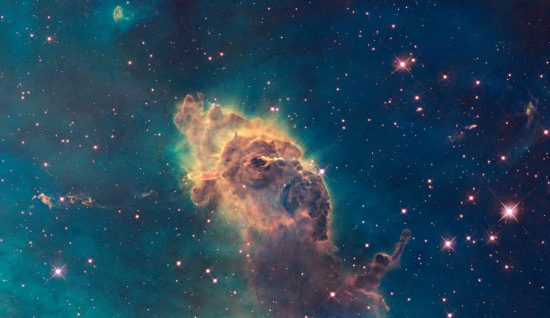
April 28, 2020
Dust at a temperature near absolute zero shows up as red and orange in this image of the Carina Nebula.
NGC 3372 is a large, bright nebulosity in the constellation Carina, located between 6500 and 10,000 light-years from Earth. Since there are so many nebulae, and all of them are thought to be where stars are born and die, it is surprising that astronomers are not sure how they form. One thing everyone agrees on is that they are very cold.
In the consensus view, cold dust is necessary when stars condense out of a nebula. As gas and dust collapse into a new star, they naturally warm up and radiate energy. According to theory, outward pressure opposes the inward force of gravity when a proto-star undergoes its initial compression. If the outward force, caused by thermal energy, overcomes the force of gravity, atoms in the proto-star will never undergo nuclear fusion. However, if gas and dust in a nebula is cold enough, it allows heat to radiate away so that a new star can ignite.
On the other hand, when the Electric Universe theory is considered, cold nebulae are evidence of electrical activity even at temperatures near absolute zero. Bipolar symmetry is typical of most nebulae, and most of them are dense enough to emit light because they are extremely hot in some regions. The middle of the Carina Nebula is cold: radio measurements indicate the dust clouds around the inner part are only one degree above absolute zero.
The filamentary structure of the “fingers” and the way the filaments spiral away from the central stars indicates Birkeland currents, named after Kristian Birkeland, who first proposed their existence in the late 1800s. Those currents form scalable tubes of plasma that can transmit electric power all around the galaxy. Electromagnetic forces sometimes cause them to pinch down to smaller and smaller sizes.
Plasma confined within the center of the pinch is crushed and increases in current density until the so-called “z-pinch” produces a star. Plasma surrounding the star will often glow as an emission nebula, but in some conditions of opacity and density the surrounding plasma can be cold, as in the Carina Nebula, revealing its presence only in infrared light.
Conventional astronomers do no know how stars throw off clouds of gas and dust that eventually become other stars because stars are not made of gas and dust. A star is the focus of Birkeland currents that make up circuits flowing around the galaxy. The electromagnetic pinch that squeezes plasma into the star also forms a toroidal current around the star’s equator. The density of the current causes the plasma in the ring to glow. The Electric Universe explanation is that we are looking at plasma structures when we look at nebulae, and they behave according to the laws of electrical discharges and circuits.
Instead of mechanical action and cold gas, the Carina Nebula’s radiant new stars are created in a boost of electric current. It is not necessary to prevent young stars from heating up by shielding them in cold dust. The electrical sheath around a new star receives input from the galactic Birkeland currents in which it is immersed and gets pushed into the glow mode discharge state. Gravity has little if anything to do with the processes of star formation.
Stephen Smith
The Thunderbolts Picture of the Day is generously supported by the Mainwaring Archive Foundation.












